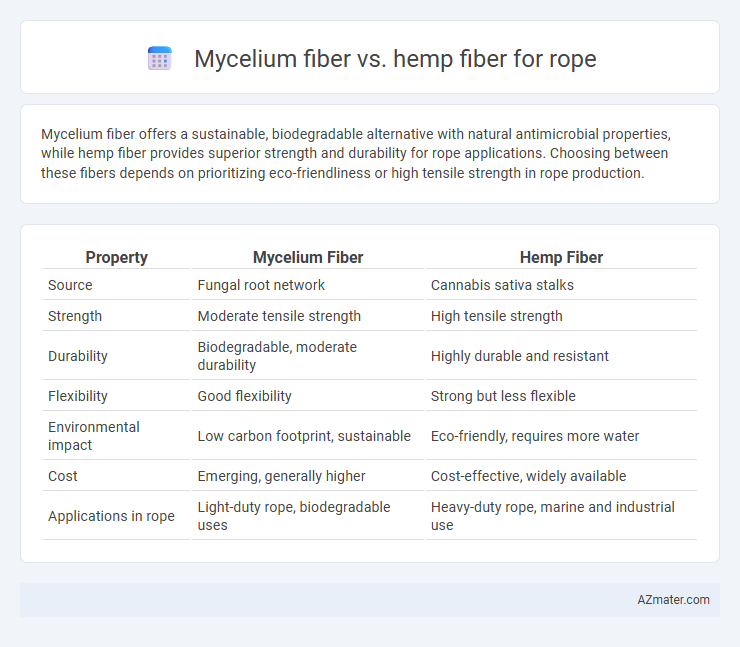Mycelium fiber offers a sustainable, biodegradable alternative with natural antimicrobial properties, while hemp fiber provides superior strength and durability for rope applications. Choosing between these fibers depends on prioritizing eco-friendliness or high tensile strength in rope production.
Table of Comparison
| Property | Mycelium Fiber | Hemp Fiber |
|---|---|---|
| Source | Fungal root network | Cannabis sativa stalks |
| Strength | Moderate tensile strength | High tensile strength |
| Durability | Biodegradable, moderate durability | Highly durable and resistant |
| Flexibility | Good flexibility | Strong but less flexible |
| Environmental impact | Low carbon footprint, sustainable | Eco-friendly, requires more water |
| Cost | Emerging, generally higher | Cost-effective, widely available |
| Applications in rope | Light-duty rope, biodegradable uses | Heavy-duty rope, marine and industrial use |
Introduction to Mycelium Fiber and Hemp Fiber
Mycelium fiber, derived from the root-like structures of fungi, offers a sustainable and biodegradable alternative to traditional fibers with its natural strength and flexibility. Hemp fiber, sourced from the stalks of the Cannabis sativa plant, is renowned for its durability, resistance to stretching, and eco-friendly cultivation. Both fibers provide unique benefits for rope production, with mycelium fiber emphasizing biodegradability and hemp fiber highlighting long-lasting toughness.
Historical Uses of Mycelium and Hemp in Rope Making
Mycelium, the root structure of fungi, has been historically less common in rope making compared to hemp, which has a rich legacy dating back thousands of years as a durable, lightweight fiber for maritime ropes and rigging. Hemp fibers, known for their tensile strength and resistance to rot, were essential in ancient seafaring civilizations, while mycelium has gained attention in modern sustainable materials research for its biodegradability and potential as an eco-friendly alternative. The contrasting historical uses highlight hemp's practical durability in traditional rope manufacturing and mycelium's emerging role in innovative, sustainable fiber applications.
Production Processes: Mycelium Fiber vs Hemp Fiber
Mycelium fiber production involves cultivating fungal mycelium on organic substrates, followed by harvesting, drying, and processing into a fibrous material, which offers a sustainable and biodegradable alternative. Hemp fiber production requires harvesting mature hemp stalks, retting to separate fibers, and mechanical processing such as decortication and combing to produce strong, durable fibers suitable for rope. Both processes emphasize eco-friendly cultivation, but mycelium fiber production allows for faster growth cycles and lower water usage compared to traditional hemp fiber processing.
Environmental Impact and Sustainability
Mycelium fiber, derived from fungal root networks, offers a rapidly renewable and biodegradable alternative to traditional hemp fiber, requiring significantly less water and no pesticides during cultivation. Hemp fiber, while also biodegradable and strong, demands more extensive agricultural inputs including substantial water and land use. The ecological footprint of mycelium fiber is lower due to its ability to grow on agricultural waste substrates, reducing waste and promoting circular economy principles in rope production.
Mechanical Strength and Durability Comparison
Mycelium fiber exhibits moderate mechanical strength suitable for lightweight applications, with tensile strength typically ranging between 20-40 MPa, whereas hemp fiber shows superior mechanical strength, often exceeding 500 MPa, making it ideal for heavy-duty rope production. Hemp fiber also demonstrates exceptional durability due to its resistance to UV exposure, moisture, and microbial degradation, whereas mycelium fibers are more prone to environmental wear unless specially treated. For industrial-grade rope, hemp fiber remains the preferred choice due to its robustness and longevity under stress.
Water Resistance and Weathering Properties
Mycelium fiber exhibits superior water resistance compared to hemp fiber, maintaining structural integrity and flexibility when exposed to moisture. Hemp fiber, while strong and durable, tends to absorb water, leading to weakening and degradation over time in wet conditions. For weathering properties, mycelium fiber resists UV degradation and microbial attack more effectively, ensuring longer-lasting rope performance in harsh outdoor environments.
Flexibility and Handling Characteristics
Mycelium fiber demonstrates superior flexibility compared to traditional hemp fiber, making it ideal for applications requiring elastic and resilient rope. Its natural interwoven hyphal structure provides excellent tensile strength while maintaining lightweight handling characteristics. In contrast, hemp fiber offers robust durability but tends to be stiffer, resulting in less pliable ropes that may be harder to manipulate for intricate knotting or dynamic movement.
Cost and Economic Feasibility
Mycelium fiber offers a sustainable alternative to hemp fiber with lower raw material costs due to its rapid growth and use of agricultural waste, making it economically feasible for rope production. Hemp fiber, while traditionally more expensive because of longer cultivation periods and labor-intensive processing, benefits from established supply chains and higher tensile strength, supporting premium pricing. Cost-efficiency in rope manufacturing depends on scale, processing technology, and market demand for eco-friendly materials, with mycelium increasingly competitive in niche sustainable markets.
Applications: Best Use Cases for Each Fiber Type
Mycelium fiber excels in eco-friendly, biodegradable rope applications such as gardening twine, packaging ties, and lightweight outdoor gear, where sustainability and compostability are crucial. Hemp fiber offers superior strength and durability, making it ideal for heavy-duty uses like marine ropes, climbing lines, and industrial lifting cords that demand high tensile strength and resistance to abrasion. Selecting between mycelium and hemp fibers depends on the balance between environmental impact and mechanical performance required for specific rope applications.
Future Prospects and Innovations in Rope Materials
Mycelium fiber and hemp fiber both offer sustainable alternatives for rope materials, with mycelium fiber emerging as a cutting-edge innovation due to its biodegradability, lightweight nature, and rapid growth cycle. Future prospects for mycelium fiber include enhanced durability and water resistance through bioengineering, potentially surpassing traditional hemp fibers known for their strength and UV resistance. Innovations in combining mycelium and hemp fibers could result in hybrid ropes that maximize tensile strength, environmental benefits, and cost-effectiveness for industrial and agricultural applications.

Infographic: Mycelium fiber vs Hemp fiber for Rope
 azmater.com
azmater.com